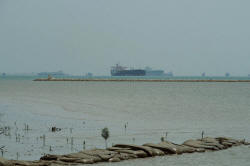|
Exclusive: In mammoth
task, BP sends almost three million barrels of U.S. oil
to Asia
 Send a link to a friend
Send a link to a friend
 [December 07, 2016]
By Florence Tan [December 07, 2016]
By Florence Tan
SINGAPORE
(Reuters) - Oil major BP is shipping almost three million barrels of
U.S. crude to customers across Asia, pioneering a lengthy and complex
operation likely to become more popular after OPEC last week announced
deep production cuts.
BP's efforts, involving one of the world's longest sea routes, seven
tankers and a series of ship-to-ship transfers, underscore a desire
among oil traders to develop new routes to sell swelling supplies of
cheap U.S. shale oil to Asia, the world's biggest consumer region.
While exports of U.S. crude have been allowed since a 40-year ban was
lifted a year ago, the distance, cost and complexity of shipping to Asia
has so far kept the flow to a trickle.
Now, using its global shipping and trading network, BP was able to
grapple with U.S. port limitations and the need to transfer oil between
ships off Malaysia to split cargoes for customers across Asia, according
to trade sources and shipping data in Thomson Reuters Eikon.
"Keeping regional price differentials, different tanker rates, and the
forward price curve in mind while considering the delivery needs and
schedules of your counterparties is not something many oil trading firms
can do," said a shipping source in Singapore, who had knowledge of the
operations.
"BP is one of perhaps half a dozen firms capable of doing so," he added,
speaking on condition of anonymity as he was not authorized to publicly
discuss operations.

BP declined to comment.
(For graphic on U.S. shale costs falling, click http://tmsnrt.rs/2fO4b17)
OPEC INCENTIVE
While BP's operations are currently the most sophisticated, others have
also begun developing U.S./Asia trade.
China's Unipec, the trading arm of Asia's largest refiner Sinopec, is
shipping about 2 million barrels of WTI to China this month, while
trading house Trafigura is also exporting some 2 million barrels of U.S.
oil to Asia.
Incentives to bring U.S. crude into Asia have risen after the Middle
East-led producer club of the Organization of the Petroleum Exporting
Countries (OPEC) and Russia agreed to cut output, encouraging refiners
across the region to seek alternatives to offset potential supply
shortfalls.
"OPEC is putting U.S. shale oil to the test... (and) we will truly see
what it can deliver," said Bjarne Schieldrop, chief commodity analyst at
SEB. He predicted 2017 would be a "shale oil party" with a surge in U.S.
exports after the OPEC production cuts.
The operation to send the oil, worth around $150 million, to
Asia-Pacific buyers lasted four months and involved BP traders in the
United States and Singapore, while colleagues from London were
responsible for ship chartering, the sources said and data showed.
BP took advantage of arbitrage between cheaper U.S. West Texas
Intermediate (WTI) <CLc1> crude and the global benchmark Brent <LCOc1>.
The deal was aided by cheap tanker rates and a price/time curve, where
future oil deliveries are more expensive than those for immediate
discharge, making sourcing oil from as far away as North America
profitable.

[to top of second column] |

Tankers are seen off the coast of Johor November 12, 2016.
REUTERS/Henning Gloystein/File Photo

FROM GOLA TO MALAYSIA
BP's operations to Asia kicked off in mid-September, when it chartered the large
Suezmax-class tanker Felicity to load crude from the smaller Aframax-class
vessel Eagle Stavanger in the Galveston Offshore Lightering Area (GOLA) off
Texas.
Days
later, also at GOLA, BP transferred oil from three Aframax-class tankers to the
C. Excellency, a Very Large Crude Carrier (VLCC)
The transfers were necessary as American ports cannot load oil on the biggest
tankers.
A VLCC can carry 2 million barrels of oil, enough to meet two days' worth of
Britain's consumption, while a Suezmax and an Aframax can load 1 million barrels
and 800,000 barrels, respectively.
Too big for the Panama Canal, the Felicity and C. Excellency sailed around South
Africa to the Linggi International Transhipment Hub in Malaysia where their
cargoes were split up again for delivery across Asia-Pacific.
In late October, the Felicity transferred part of its oil to the smaller Aframax
Taurus Sun, which then delivered 300,000 barrels of WTI Midland crude to
Thailand, according to shipping data.
The C.
Excellency received the rest of the Felicity's cargo in Malaysia, then
transferred oil to Aframax-class British Gannet in November.
On Wednesday, shipping data shows that the British Gannet docked at BP's Kwinana
refinery in Perth, Australia to make its final delivery. The cargo will have
traveled more than 16,000 nautical miles (30,000 km) from GOLA.
Meanwhile, C. Excellency received some fuel from another super-tanker, the
Gener8 Andriotis, and this week headed to Sriracha in Thailand to deliver
300,000 barrels of WTI, shipping data showed. Sources involved with the shipment
said some of that oil would likely proceed to Japan.
While BP's operation stands out size and complexity, more long-haul trades are
likely.

"As Middle East producers and Russia are due to cut their output, large crude
buyers (in Asia)... will likely import an incremental amount from longer-haul
sources," said Erik Nikolai Stavseth from Norway's Arctic Securities.
(Additional reporting by Liz Hampton and Marianna Parraga in HOUSTON, Catherine
Ngai in NEW YORK, and Keith Wallis in SINGAPORE; Editing by Henning Gloystein
and Lincoln Feast)
[© 2016 Thomson Reuters. All rights
reserved.] Copyright 2016 Reuters. All rights reserved. This material may not be published,
broadcast, rewritten or redistributed. |